|
Throughout
history, mankind has been naturally predisposed to look
for ways of making life easier and more efficient. Many
times this meant inventing tools to reduce the physical
effort in daily tasks and, as time went by, man got
creative and started thinking of ways to make tools work
by themselves. This tendency brought about the dawn of
automations, also known as automata. For the purpose of
clarity hereafter, by “automata” we will generally refer
to any of numerous mechanical objects that are
moderately self-operating after being set in motion. The
ultimate product of this development is of course the
robots of today and tomorrow, but here we will
concentrate on the specific historical contributions of
Al Jaziri, a Muslim inventor of the 13th
century AD. Understanding the importance of this Islamic
innovator’s achievements in automata helps us take a
sneak peek into the roots of today’s hi-tech
automations.
Al
Jaziri’s Early Life
Al
Jaziri’s complete name was Badi Al Zaman Abul I Ezz Ibn
Ismail Ibn Al Razzaz Al Jaziri. He lived some eight
centuries ago. The exact date of his birth is unknown,
but the Al Jaziri part of his name, by which he became
famous, refers to the area where he was born. The region
was known as Al Jazira, which is found in present-day
Iraq between the Tigris and the Euphrates.
During his life,
Al Jaziri devoted a long part of his professional career
away from his homeland to serve the Urtuq court of Diyar
Bakir in Upper Mesopotamia, which is in present-day
Turkey. In doing so, he followed his father’s steps who
also worked under the Diyar Bakir partons. Al Jaziri
spent more or less twenty-seven years from 1174 AD to
1200 AD under the benefaction of the Urtuq princes.
There he specialized as an innovator in mechanical
engineering and became the chief mechanical engineer of
the court. Al Jaziri’s inventive mindset was in tune
with the prevalent socio-cultural trend in the Islamic
world in this and the preceding couple of centuries when
a number of important scientific inventions were made.
Luckily, some of the best detailed of those in ancient
manuscripts are the complex mechanical arrangements of
the water-operated automatons. These included devices
such as the water clock and other hydraulic mechanisms
invented and made by Al Jaziri himself.
Al
Jaziri’s Magnum Opus - A True Book of Knowledge
Al
Jaziri earned his well-deserved fame not just by being a
great inventor and a great mechanical engineer. What
helped spread the word about his ingenuity and helped
people admire him for centuries to come was a
well-documented, systematic series of manuscripts he
kept about all his work. This eventually evolved into
his famous book which he called “The Book of Knowledge
of Ingenious Mechanical Devices,” or in Arabic – “Al Jami' Bain Al 'Ilm Wal 'Amal Al Nafi Fi Sina'at Al Hiyal.”
He compiled the complete volume in 1206 AD. Quite
appropriately, some sources refer to the same book
simply as “Automata.”
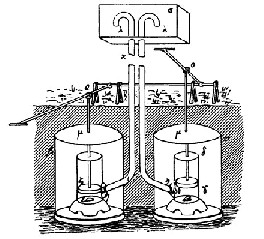
Al Jaziri began
putting together his manuscripts into a coherent volume
partly because of a request by his sovereign, Sultan Nur
Al Din Mahmud. As one might think, by all accounts it
seems Al Jaziri was only happy to oblige. In essence,
his book became a compendium of theoretical and
practical mechanics. It has been admired in scientific
circles as the most highly developed of its kind at the
time and is often seen as exemplary of the peak of this
movement of Muslim achievement. In this work, Al Jaziri
put forth the basis of numerous methods and models that
would set the foundation of mechanical engineering
today.
Al Jaziri's “Al
Jami' Bain Al 'Ilm Wal 'Amal Al Nafi Fi Sina'at Al Hiyal”
distinguishes between six general classes of mechanical
apparatus. This has a great influence on the way they
were later categorized in Europe in the Renaissance and
afterwards, not least because he described the
techniques of construction meticulously and precisely.
Notably, the only reason for the unexpected emergence of
the suction pump device in the manuscripts of the
Renaissance engineers in Europe is that the idea was
borrowed from Islamic engineers, Al Jaziri in
particular, who were familiar with the pumps long before
this period during the Middle Ages. Furthermore, Prof.
Lynn White Jr. observed that segmental gears first
clearly appear in Al-Jaziri’s writings, whereas in
Europe they appear in Giovanni de Dondi's astronomical
clock finished much later in 1364. Likewise, cranks were
first mentioned in Al Jaziri’s book, some 300 years
earlier than European engineers could make use of them,
Leonardo Da Vinci
being one of the first to do so.
Throughout Al Jaziri’s
book, there are descriptions of over fifty other
machines, including water clocks, a hand washing device
known as a “wadu machine,” and perhaps most
significantly – Al Jazari’s machines for raising water.
Raising Water with Machines
The
first couple of machines for raising water that Al
Jazari describes in his book are amendments to the
shaduf. These improved devices employed a flume beam. In
other words, as a substitute to a pole, an open channel
is linked to a scoop, which has its spout elongated into
a flume. The scoop dips into the water and when the beam
rises, the water flows back through the channel and runs
out into the irrigation system. These water raising
machines were animal driven as in the saqiya.
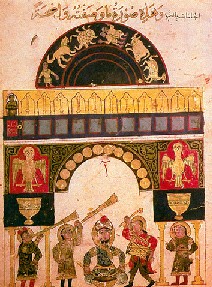
The third water
raising machine that Al Jaziri devised was an advance
model from the saqiya in which water drives the motion.
This essentially eliminated the need for animals to run
the machine, making it more self sufficient. In this
case, running water helps rotate a water wheel which,
through a mechanism of interconnecting perpendicular
gears, makes a series of linked filled pots raise the
water. One known example of this kind of a water raising
machine was to be found on the Yazid River in 13th
century Damascus, Syria, serving the needy at a local
hospital.
The fourth water
raising machine also made use of the flume beam and was
again driven by animal power. The flume beam was shifted
up and then down by a relatively complex apparatus
connecting gears with a crank. Notably, this is the
first ever recorded use of a crank as a machine
component. In comparison, in Europe the first known use
of a crank as a machine element took place much later in
the fifteenth century AD.
The fifth water
raising machine that Al Jaziri devised was again hydro
powered. It was a pump in which a water wheel rotated a
vertical cog wheel which in turn rotated a horizontal
wheel. The horizontal wheel made two linked opposing
copper pistons move back and forth. The cylinders of the
pistons were attached to pipes for suction and delivery
together. The suction pipes pulled out water from a
water supply underneath, and the delivery pipes released
the water into the impressive output point of some 12
meters over the mechanism. This machine was one of the
first to put into practice the double-acting theory - at
the same time as one piston sucks, the other one
delivers the water.
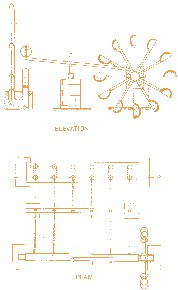 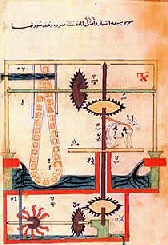
Other Highlights in Al Jaziri’s Book
The explanations
offered in Jaziri’s Book
of Knowledge of Ingenious Mechanical Devices were easy
to understand as they were very well illustrated. The
illustrations most often showed the device being used in
a practical setting. For example, one illustration
included an
automata where
an Arab woman is filling and emptying a wash basin;
another depicted a lavish elephant-clock.
Also featured in
the book were other water clocks which use progressing
balls to ring out the hours on cymbals. In one of these
clocks, balls are released from two falcons’ mouths on
the hour to fall on cymbals positioned below. Another
clock makes use of a sloping waterway to discharge
balls.
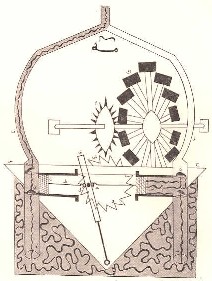
In addition to
the elaborate explanations and illustrations, Al
Jaziri's book is a masterpiece from a practical point of
view for the very reason that the person behind it was
indeed such an experienced mechanical engineer. He
structured his explanations in such a manner so as to
make them very understandable to his readers. There is
no room for guesswork on the reader’s part - the text
clearly explains the different machines to the last
facet. Donald Hill, a British Charter engineer who
specialized in Arab traditional technology wrote in 1974
that “It is impossible to overemphasize the importance
of Al Jaziri's work in the history of engineering; it
provides a wealth of instructions for design,
manufacture and assembly of machines.” Two years later,
in 1976 at the “World of Islam Festival” held in the
United Kingdom, a tribute was paid to Al Jaziri when the
London Science Museum showed a reconstructed functioning
replica of his famous Water Clock.
One of Al
Jaziri’s pumps: using the earliest known suction pipe in
a pump, the double acting principle, and the conversion
of rotary to reciprocating motion. This mechanism plays
an essential role in the advance of the steam engine and
also that of modern reciprocating pumps.
Overall, when we
look at all of Al Jaziri’s work, we cannot help but
admire this 13th century Muslim engineering
genius. All his inventions and innovations have one
underlying purpose – to make everyday life easier for
the people engaged in laborious tasks. His inventions
were all very practical and very efficient. Although he
worked under the patronage of dynasty rulers, his
creations aimed to alleviate life of the ordinary man
and woman in their daily struggles. | 